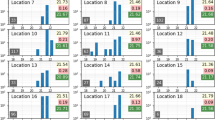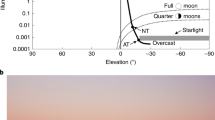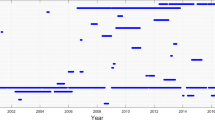Abstract
Night sky brightness (NSB) measurements inform both the selection of new ground-based optical and near-infrared astronomical observatory sites and the management of night-time conditions near existing facilities. NSB modelling supports site characterization in cases where obtaining in situ measurements is difficult and provides additional information about the photic environment. Models of NSB conventionally assume Mie scattering, but we show that predominantly at low-altitude sites contaminated by artificial light, this assumption may result in significant errors up to a factor of ~2.5. This effect introduces systematic bias to models of anthropogenic skyglow, but more realistic modelling approaches tend to be computationally intensive. We demonstrate the significance of these effects by simulating NSB while accounting for increasingly realistic populations of aerosol components. The use of approximate scattering phase functions reduces computing time while yielding results that reasonably match field observations. This approach can speed up models used to predict NSB while increasing their accuracy.
This is a preview of subscription content, access via your institution
Access options
Access Nature and 54 other Nature Portfolio journals
Get Nature+, our best-value online-access subscription
$29.99 / 30 days
cancel any time
Subscribe to this journal
Receive 12 digital issues and online access to articles
$119.00 per year
only $9.92 per issue
Buy this article
- Purchase on Springer Link
- Instant access to full article PDF
Prices may be subject to local taxes which are calculated during checkout




Similar content being viewed by others
Data availability
The numerical results for the all-sky radiance distributions were computed using the model available in ref. 10. The scattering phase functions for dust particles and spherical particles are retrievable in graphical form from ref. 31. Normalized phase functions in digitized form and experimental and computed NSB distributions are available from the corresponding author upon reasonable request. All data that support this study are available in the Supplementary Information.
References
Green, R. F., Luginbuhl, C. B., Wainscoat, R. J. & Duriscoe, D. The growing threat of light pollution to ground-based observatories. Astron. Astrophys. Rev. 30, 1 (2022).
Kyba, C. C. M. Is light pollution getting better or worse? Nat. Astron. 2, 267–269 (2018).
Kyba, C. et al. Worldwide variations in artificial skyglow. Sci. Rep. 5, 8409 (2015).
Kyba, C. C. M. et al. Artificially lit surface of Earth at night increasing in radiance and extent. Sci. Adv. 3, e1701528 (2017).
Barentine, J. C. et al. Skyglow changes over Tucson, Arizona, resulting from a municipal LED street lighting conversion. J. Quant. Spectrosc. Radiat. Transf. 212, 10–23 (2018).
Hung, L.-W., Anderson, S. J., Pipkin, A. & Fristrup, K. Changes in night sky brightness after a countywide LED retrofit. J. Environ. Manage. 292, 112776 (2021).
Gaston, K. J., Davies, T. W., Bennie, J. & Hopkins, J. Review. Reducing the ecological consequences of night-time light pollution: options and developments. J. Appl. Ecol. 49, 1256–1266 (2012).
Kocifaj, M. & Barentine, J. C. Air pollution mitigation can reduce the brightness of the night sky in and near cities. Sci. Rep. 11, 14622 (2021).
Aubé, M. Physical behaviour of anthropogenic light propagation into the nocturnal environment. Philos. Trans. R. Soc. B 370, 20140117 (2015).
Kocifaj, M. Multiple scattering contribution to the diffuse light of a night sky: a model which embraces all orders of scattering. J. Quant. Spectrosc. Radiat. Transf. 206, 260–272 (2018).
Duriscoe, D., Luginbuhl, C. & Elvidge, C. The relation of outdoor lighting characteristics to sky glow from distant cities. Light. Res. Technol. 46, 35–49 (2014).
Kocifaj, M., Kundracik, F., Duriscoe, D. M., Balm, S. P. & Wallner, S. Using ground-based measurements to recover the spectra of radiation escaping from distant light-pollution sources. MNRAS 506, 2739–2745 (2021).
Lamphar, H., Wallner, S. & Kocifaj, M. Modelled impacts of a potential light emitting diode lighting system conversion and the influence of an extremely polluted atmosphere in Mexico City. Environ. Plan. B Urban Anal. City Sci. 49, 501–518 (2021).
Horvath, H. Basic optics, aerosol optics, and the role of scattering for sky radiance. J. Quant. Spectrosc. Radiat. Transf. 139, 3–12 (2014).
Louedec, K. & Urban, M. Ramsauer approach for light scattering on nonabsorbing spherical particles and application to the Henyey–Greenstein phase function. Appl. Opt. 51, 7842–7852 (2012).
Acosta-Herazo, R., Monterroza-Romero, J., Mueses, M. Á., Machuca-Martínez, F. & Puma, G. L. Coupling the six flux absorption–scattering model to the Henyey–Greenstein scattering phase function: evaluation and optimization of radiation absorption in solar heterogeneous photoreactors. Chem. Eng. J. 302, 86–96 (2016).
Gouesbet, G. Van de Hulst essay: a review on generalized Lorenz–Mie theories with wow stories and an epistemological discussion. J. Quant. Spectrosc. Radiat. Transf. 253, 107117 (2020).
Dlugach, J. M. & Mishchenko, M. I. Effects of nonsphericity on the behavior of Lorenz–Mie resonances in scattering characteristics of liquid-cloud droplets. J. Quant. Spectrosc. Radiat. Transf. 146, 227–234 (2014).
Mishchenko, M. I., Travis, L. D., Kahn, R. A. & West, R. A. Modeling phase functions for dustlike tropospheric aerosols using a shape mixture of randomly oriented polydisperse spheroids. J. Geophys. Res. Atmos. 102, 16831–16847 (1997).
Lin, W., Bi, L. & Dubovik, O. Assessing superspheroids in modeling the scattering matrices of dust aerosols. J. Geophys. Res. Atmos. 123, 13917–13943 (2018).
Dabrowska, D. D. et al. Scattering matrices of Martian dust analogs at 488nm and 647nm. Icarus 250, 83–94 (2015).
Lee, R. L. & Hernández-Andrés, J. Measuring and modeling twilight’s purple light. Appl. Opt. 42, 445–457 (2003).
Cinzano, P. Night sky photometry with Sky Quality Meter. Technical report 9, V1.4, ISTIL; http://unihedron.com/projects/darksky/sqmreport_v1p4.pdf (2005).
Pun, C. S. J., So, C. W., Leung, W. Y. & Wong, C. F. Contributions of artificial lighting sources on light pollution in Hong Kong measured through a night sky brightness monitoring network. J. Quant. Spectrosc. Radiat. Transf. 139, 90–108 (2014).
Kocifaj, M., Solano-Lamphar, H. A. & Videen, G. Night-sky radiometry can revolutionize the characterization of light-pollution sources globally. PNAS 116, 7712–7717 (2019).
Duriscoe, D. M. Measuring anthropogenic sky glow using a natural sky brightness model. Publ. Astron. Soc. Pac. 125, 1370–1382 (2013).
Grauer, A. D. & Grauer, P. A. Linking solar minimum, space weather, and night sky brightness. Sci. Rep. 11, 23893 (2021).
Liu, X. et al. Influences of relative humidity and particle chemical composition on aerosol scattering properties during the 2006 PRD campaign. Atmos. Environ. 42, 1525–1536 (2008).
Liu, X. et al. Research on the hygroscopic properties of aerosols by measurement and modeling during CAREBeijing-2006. J. Geophys. Res. Atmos. 114, D00G16 (2009).
Day, D. E. & Malm, W. C. Aerosol light scattering measurements as a function of relative humidity: a comparison between measurements made at three different sites. Atmos. Environ. 35, 5169–5176 (2001).
Nousiainen, T., Muinonen, K. & Räisänen, P. Scattering of light by large Saharan dust particles in a modified ray optics approximation. J. Geophys. Res. Atmos. 108, 4025 (2003).
Riziq, A. A., Erlick, C., Dinar, E. & Rudich, Y. Optical properties of absorbing and non-absorbing aerosols retrieved by cavity ring down (CRD) spectroscopy. Atmos. Chem. Phys. 7, 1523–1536 (2007).
Kocifaj, M., Horvath, H. & Gangl, M. Retrieval of aerosol aspect ratio from optical measurements in Vienna. Atmos. Environ. 42, 2582–2592 (2008).
Peterson, M. Modeling the transmission of optical lightning signals through complex 3-D cloud scenes. J. Geophys. Res. Atmos. 125, e2020JD033231 (2020).
Heng, K., Morris, B. M. & Kitzmann, D. Closed-form ab initio solutions of geometric albedos and reflected light phase curves of exoplanets. Nat. Astron. 5, 1001–1008 (2021).
Fu, Q., Thorsen, T. J., Su, J., Ge, J. M. & Huang, J. P. Test of Mie-based single-scattering properties of non-spherical dust aerosols in radiative flux calculations. J. Quant. Spectrosc. Radiat. Transf. 110, 1640–1653 (2009).
Muinonen, K. & Videen, G. A phenomenological single scatterer for studies of complex particulate media. J. Quant. Spectrosc. Radiat. Transf. 113, 2385–2390 (2012).
Stelitano, D., Di Girolamo, P., Scoccione, A., Summa, D. & Cacciani, M. Characterization of atmospheric aerosol optical properties based on the combined use of a ground-based Raman lidar and an airborne optical particle counter in the framework of the hydrological cycle in the Mediterranean Experiment – Special Observation Period 1. Atmos. Meas. Tech. 12, 2183–2199 (2019).
Chin, M. et al. Tropospheric aerosol optical thickness from the GOCART model and comparisons with satellite and sun photometer measurements. J. Atmos. Sci. 59, 461–483 (2002).
Braun, B., Dorgan, J. R. & Chandler, J. P. Cellulosic nanowhiskers: theory and application of light scattering from polydisperse spheroids in the Rayleigh–Gans–Debye regime. Biomacromolecules 9, 1255–1263 (2008).
Wyatt, P. J. Measuring nanoparticles in the size range to 2000 nm. J. Nanopart. Res. 20, 322 (2018).
Gordon, H. R. Rayleigh–Gans scattering approximation: surprisingly useful for understanding backscattering from disk-like particles. Opt. Express 15, 5572–5588 (2007).
Lui, C. W., Clarkson, M. & Nicholls, R. W. An approximation for spectral extinction of atmospheric aerosols. J. Quant. Spectrosc. Radiat. Transf. 55, 519–531 (1996).
Veretennikov, V. V. & Men’shchikova, S. S. Reconstruction of the aerosol microstructure from measurements of light extinction in the atmosphere under restriction of the spectral range. Atmos. Ocean. Opt. 29, 18–26 (2016).
Mishchenko, M. I. & Travis, L. D. Capabilities and limitations of a current FORTRAN implementation of the T-matrix method for randomly oriented, rotationally symmetric scatterers. J. Quant. Spectrosc. Radiat. Transf. 60, 309–324 (1998).
Draine, B. T. & Flatau, P. J. Discrete dipole approximation for scattering calculations. J. Opt. Soc. Am. A 11, 1491–1499 (1994).
Korras-Carraca, M. B., Hatzianastassiou, N., Matsoukas, C., Gkikas, A. & Papadimas, C. D. The regime of aerosol asymmetry parameter over Europe, the Mediterranean and the Middle East based on MODIS satellite data: evaluation against surface AERONET measurements. Atmos. Chem. Phys. 15, 13113–13132 (2015).
Mishchenko, M. I., Travis, L. D. & Macke, A. Scattering of light by polydisperse, randomly oriented, finite circular cylinders. Appl. Opt. 35, 4927–4940 (1996).
Puschnig, J., Wallner, S. & Posch, T. Circalunar variations of the night sky brightness – an FFT perspective on the impact of light pollution. MNRAS 492, 2262–2637 (2020).
Korras-Carraca, M. B., Gkikas, A., Matsoukas, C. & Hatzianastassiou, N. Global clear-sky aerosol speciated direct radiative effects over 40 years (1980–2019). Atmosphere 12, 1254 (2021).
Mishchenko, M. I. Electromagnetic scattering by nonspherical particles: a tutorial review. J. Quant. Spectrosc. Radiat. Transf. 110, 808–832 (2009).
Fiorentin, P., Cavazzani, S., Ortolani, S., Bertolo, A. & Binotto, R. Instrument assessment and atmospheric phenomena in relation to the night sky brightness time series. Measurement 191, 110823 (2022).
Nousiainen, T., Zubko, E., Lindqvist, H., Kahnert, M. & Tyynelä, J. Comparison of scattering by different nonspherical, wavelength-scale particles. J. Quant. Spectrosc. Radiat. Transf. 113, 2391–2405 (2012).
Liu, L. et al. Optical properties of morphologically complex black carbon aerosols: effects of coatings. J. Quant. Spectrosc. Radiat. Transf. 281, 108080 (2022).
Tiwari, S. et al. Study of the carbonaceous aerosol and morphological analysis of fine particles along with their mixing state in Delhi, India: a case study. Environ. Sci. Pollut. Res. 22, 10744–10757 (2015).
Shao, L. et al. Morphology, composition and mixing state of individual airborne particles: effects of the 2017 Action Plan in Beijing, China. J. Clean. Prod. 329, 129748 (2021).
Kundracik, F., Kocifaj, M., Videen, G. & Markoš, P. Optical properties of charged nonspherical particles determined using the discrete dipole approximation. J. Quant. Spectrosc. Radiat. Transf. 254, 107245 (2020).
Samset, B. H. et al. Aerosol absorption: progress towards global and regional constraints. Curr. Clim. Change Rep. 4, 65–83 (2018).
Shen, L. et al. Characterizing regional aerosol pollution in central China based on 19 years of MODIS data: spatiotemporal variation and aerosol type discrimination. Environ. Pollut. 263, 114556 (2020).
Mishchenko, M. I. Electromagnetic Scattering by Particles and Particle Groups: An Introduction (Cambridge Univ. Press, 2014); https://www.cambridge.org/core_title/gb/321854
Li, L. et al. Studying aerosol light scattering based on aspect ratio distribution observed by fluorescence microscope. Opt. Express 25, A813–A823 (2017).
Matsuki, A. et al. Cloud processing of mineral dust: direct comparison of cloud residual and clear sky particles during AMMA aircraft campaign in summer 2006. Atmos. Chem. Phys. 10, 1057–1069 (2010).
Li, L. I. et al. Effects of the shape distribution of aerosol particles on their volumetric scattering properties and the radiative transfer through the atmosphere that includes polarization. Appl. Opt. 58, 1475–1484 (2019).
Mishra, S. K. et al. Morphology of atmospheric particles over semi-arid region (Jaipur, Rajasthan) of India: implications for optical properties. Aerosol Air Qual. Res. 15, 974–984 (2015).
Mishchenko, M. I. & Travis, L. D. Light scattering by polydispersions of randomly oriented spheroids with sizes comparable to wavelengths of observation. Appl. Opt. 33, 7206–7225 (1994).
Schafer, J. S. et al. Intercomparison of aerosol single-scattering albedo derived from AERONET surface radiometers and LARGE in situ aircraft profiles during the 2011 DRAGON-MD and DISCOVER-AQ experiments. J. Geophys. Res. Atmos. 119, 7439–7452 (2014).
Tang, J. et al. Positive relationship between liquid cloud droplet effective radius and aerosol optical depth over Eastern China from satellite data. Atmos. Environ. 84, 244–253 (2014).
Zhao, H. et al. Climatological variations in aerosol optical depth and aerosol type identification in Liaoning of Northeast China based on MODIS data from 2002 to 2019. Sci. Total Environ. 781, 146810 (2021).
Randles, C. A. et al. The MERRA-2 aerosol reanalysis, 1980 onward. Part I: system description and data assimilation evaluation. J. Clim. 30, 6823–6850 (2017).
Volten, H. et al. Scattering matrices of mineral aerosol particles at 441.6 nm and 632.8 nm. J. Geophys. Res. 106, 17375–17401 (2001).
Tai, H., Zhuang, Z., Jiang, L. & Sun, D. Visibility measurement in an atmospheric environment simulation chamber. Curr. Opt. Photonics 1, 186–195 (2017).
Acknowledgements
This work was supported by the Slovak Research and Development Agency under contract no. APVV-18-0014. Computational work was supported by the Slovak National Grant Agency VEGA (grant no. 2/0010/20). This work is part of the project for which the financial means was provided by the European Union’s Horizon 2020 Research and Innovation Programme on the basis of the Grant Agreement under the Marie Skłodowska-Curie funding mechanism no. 945478 - SASPRO 2.
Author information
Authors and Affiliations
Contributions
M.K. designed and performed the research. L.K. conducted Mie, T-matrix and discrete dipole approximation computations, while M.K. computed all-sky radiance using MSOS-LP1 and analysed and interpreted the results obtained. H.L. processed the data graphically, S.W. performed field experiments and J.B. reviewed and commented on findings. M.K., J.B. and S.W. wrote the paper.
Corresponding author
Ethics declarations
Competing interests
The authors declare no competing interests.
Peer review
Peer review information
Nature Astronomy thanks Stefano Cavazzani, Johannes Puschnig and Jessica Arnold for their contribution to the peer review of this work.
Additional information
Publisher’s note Springer Nature remains neutral with regard to jurisdictional claims in published maps and institutional affiliations.
Supplementary information
Supplementary Information
Supplementary Figs. 1–6 and text.
Rights and permissions
Springer Nature or its licensor (e.g. a society or other partner) holds exclusive rights to this article under a publishing agreement with the author(s) or other rightsholder(s); author self-archiving of the accepted manuscript version of this article is solely governed by the terms of such publishing agreement and applicable law.
About this article
Cite this article
Kocifaj, M., Kómar, L., Lamphar, H. et al. A systematic light pollution modelling bias in present night sky brightness predictions. Nat Astron 7, 269–279 (2023). https://doi.org/10.1038/s41550-023-01916-y
Received:
Accepted:
Published:
Issue Date:
DOI: https://doi.org/10.1038/s41550-023-01916-y



